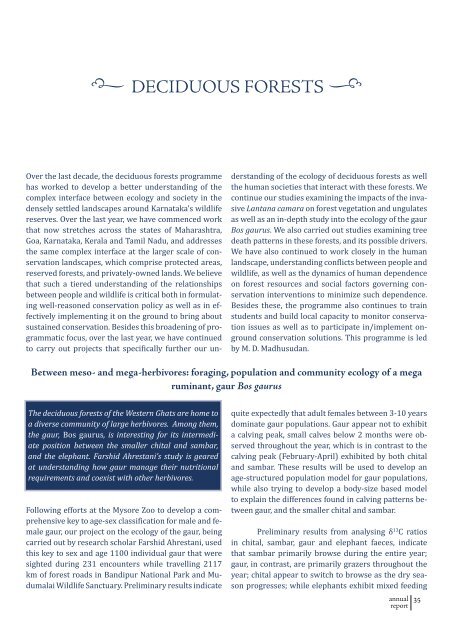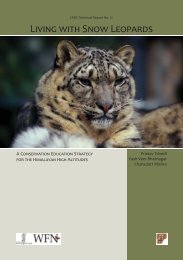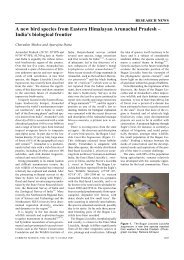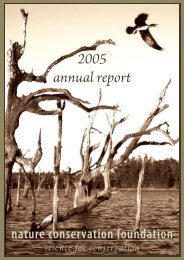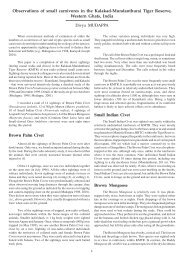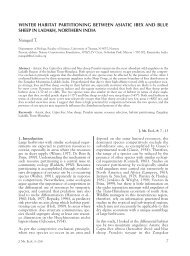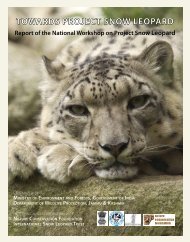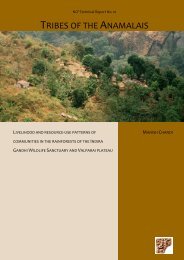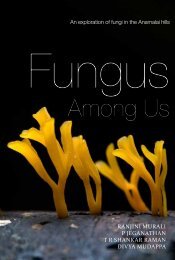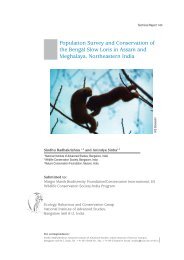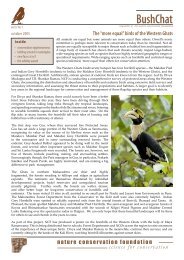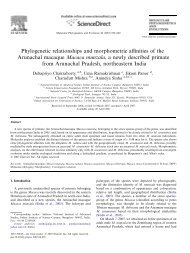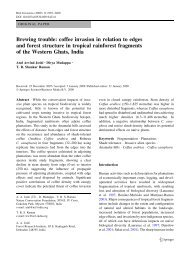2006-7 annual report - Nature Conservation Foundation
2006-7 annual report - Nature Conservation Foundation
2006-7 annual report - Nature Conservation Foundation
Create successful ePaper yourself
Turn your PDF publications into a flip-book with our unique Google optimized e-Paper software.
i DECIDUOUS FORESTS j<br />
Over the last decade, the deciduous forests programme<br />
has worked to develop a better understanding of the<br />
complex interface between ecology and society in the<br />
densely settled landscapes around Karnataka’s wildlife<br />
reserves. Over the last year, we have commenced work<br />
that now stretches across the states of Maharashtra,<br />
Goa, Karnataka, Kerala and Tamil Nadu, and addresses<br />
the same complex interface at the larger scale of conservation<br />
landscapes, which comprise protected areas,<br />
reserved forests, and privately-owned lands. We believe<br />
that such a tiered understanding of the relationships<br />
between people and wildlife is critical both in formulating<br />
well-reasoned conservation policy as well as in effectively<br />
implementing it on the ground to bring about<br />
sustained conservation. Besides this broadening of programmatic<br />
focus, over the last year, we have continued<br />
to carry out projects that specifically further our un-<br />
derstanding of the ecology of deciduous forests as well<br />
the human societies that interact with these forests. We<br />
continue our studies examining the impacts of the invasive<br />
Lantana camara on forest vegetation and ungulates<br />
as well as an in-depth study into the ecology of the gaur<br />
Bos gaurus. We also carried out studies examining tree<br />
death patterns in these forests, and its possible drivers.<br />
We have also continued to work closely in the human<br />
landscape, understanding conflicts between people and<br />
wildlife, as well as the dynamics of human dependence<br />
on forest resources and social factors governing conservation<br />
interventions to minimize such dependence.<br />
Besides these, the programme also continues to train<br />
students and build local capacity to monitor conservation<br />
issues as well as to participate in/implement onground<br />
conservation solutions. This programme is led<br />
by M. D. Madhusudan.<br />
Between meso- and mega-herbivores: foraging, population and community ecology of a mega<br />
ruminant, gaur Bos gaurus<br />
The deciduous forests of the Western Ghats are home to<br />
a diverse community of large herbivores. Among them,<br />
the gaur, Bos gaurus, is interesting for its intermediate<br />
position between the smaller chital and sambar,<br />
and the elephant. Farshid Ahrestani’s study is geared<br />
at understanding how gaur manage their nutritional<br />
requirements and coexist with other herbivores.<br />
Following efforts at the Mysore Zoo to develop a comprehensive<br />
key to age-sex classification for male and female<br />
gaur, our project on the ecology of the gaur, being<br />
carried out by research scholar Farshid Ahrestani, used<br />
this key to sex and age 1100 individual gaur that were<br />
sighted during 231 encounters while travelling 2117<br />
km of forest roads in Bandipur National Park and Mudumalai<br />
Wildlife Sanctuary. Preliminary results indicate<br />
quite expectedly that adult females between 3-10 years<br />
dominate gaur populations. Gaur appear not to exhibit<br />
a calving peak, small calves below 2 months were observed<br />
throughout the year, which is in contrast to the<br />
calving peak (February-April) exhibited by both chital<br />
and sambar. These results will be used to develop an<br />
age-structured population model for gaur populations,<br />
while also trying to develop a body-size based model<br />
to explain the differences found in calving patterns between<br />
gaur, and the smaller chital and sambar.<br />
Preliminary results from analysing δ 13 C ratios<br />
in chital, sambar, gaur and elephant faeces, indicate<br />
that sambar primarily browse during the entire year;<br />
gaur, in contrast, are primarily grazers throughout the<br />
year; chital appear to switch to browse as the dry season<br />
progresses; while elephants exhibit mixed feeding<br />
<strong>annual</strong><br />
<strong>report</strong><br />
35


